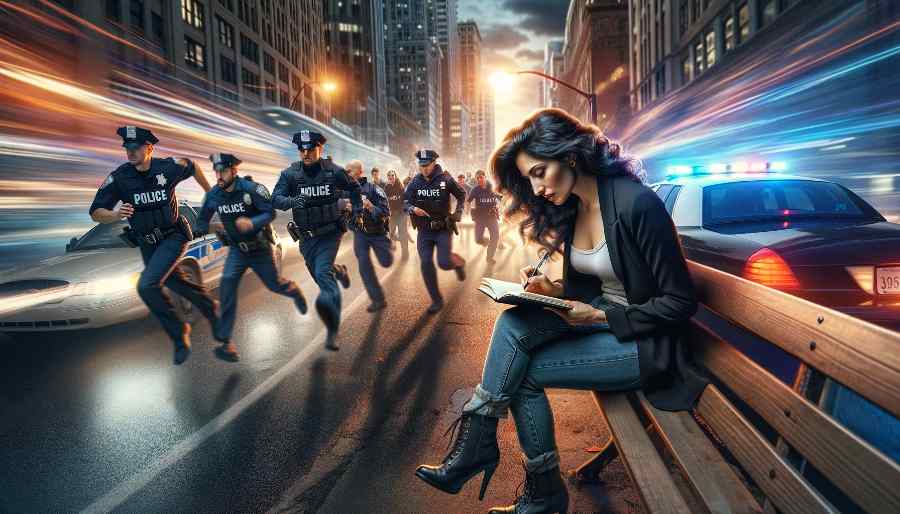Story Conflict
by N. Strauss
Story Conflict - Skip to Topic
- Why you need conflict in a story
- Coming up with a story conflict
- Types of story conflict
- Conflict and plot structure
- Plot complications
- Organizing your story middle
Why you need conflict in a story
Two characters, Martha and Steve, fall in love at first sight, then enjoy a series of successful dates. Everything is going well for those two, but not for the author writing their story, who is running out of things for the couple to talk about over dinner or as they walk hand-in-hand along the beach.
"Gee," Martha says, as they relax together on her front porch, "it's nice to feel so comfortable with someone you can just sit quietly together."
"Yep, it sure is," Steve agrees.
Silence.
The couple is content in each other's company. The author is tearing out her hair.
Well, Martha and Steve, to quote a stereotypical movie villain—"We have ways of making you talk..."
For example, we can give Steve a wife that he neglected to mention to Martha—and let Martha find out by accident...
Ooh, look, now they have something to talk about!
Dialing up the pressure

I frequently hear from writers who begin stories and then quickly run out of steam. Nothing seems to be happening.
The cause: lack of story conflict.
Conflict in a story refers to a character's struggle to overcome a problem or reach a goal.
Conflict gives the character something to do and makes things happen.
If your story's falling flat...
If not enough is going on...
If you're not sure what to write next...
... Make sure your character has a problem they have to deal with right now.
If they already have a problem, and things still feel a little blah, then make the problem worse.
Keep dialing up the pressure on your character until they do something interesting.
Coming up with a story conflict
Let's say you want to write a love story about a sweet couple named Steve and Martha...
...Or you want to write a story inspired by your grandmother's career as a successful opera singer...
...Or you want to write about a boarding school for dragons...
Great! But you'll want to develop your idea to include a conflict facing the main character. Otherwise, the idea is likely to fizzle out quickly once you start writing.
Knowing your story conflict will also help you figure out the beginning and ending of your story. I'll talk more about that soon. But first, let's look at how to add conflict to a story idea
BEFORE: Steve and Martha fall in love.
AFTER: Martha is in love with Steve, but he's married to someone else.
BEFORE: Helen becomes a successful opera singer.
AFTER: Helen longs to become an opera singer, but her traditional parents forbid her to pursue a musical career.
BEFORE: Boarding school for dragons.
AFTER: Soon after Vlak goes to a boarding school for dragons, the school comes under threat from an ancient society of dragon slayers.
Types of story conflict

Here are some types of conflict in a story...
1) Character Versus Self. Some stories are centered around internal conflict. The character struggles with their own weakness, fears, inner demons, etc.
2) Character Versus Character. In many stories, the character struggles against an antagonist. This might be an evil villain, or it might just be someone who happens to be in the character's way (e.g., Steve's perfectly nice wife, whose existence stands in the way of Steve's love story with Martha).
3) Character Versus Nature. The character might struggle to survive a natural disaster, bear attacks, being lost in the Arctic, etc.
4) Character Versus Society. The character might struggle against social expectations or laws.
5) Character Versus Machine/Technology. Artificial intelligence, robots, or a carnivorous vacuum cleaner might come after your character.
6) Character Versus the Supernatural. The character might struggle against monsters, zombies, ghosts, etc.
7) Character Versus the Unknown. This kind of conflict is common in mystery and suspense stories, where the character struggles to uncover a secret.
These categories aren't mutually exclusive. For example, every other type of conflict (character versus society, character versus nature, character versus the supernatural, etc.) is more interesting when it also forces the character to battle some aspect of themselves.
Conflict and story structure
Conflict is the backbone of a classic story plot.
- The story beginning sets up the conflict.
- The middle shows the conflict building until it reaches a breaking point, which is the story climax.
- The ending shows or hints at the result of the conflict.
Once you've figured out what the main story conflict is, it becomes much easier to structure your story.
For example, let's say our conflict is a love triangle involving Martha, Steve, and Steve's wife.
During the first part of the story, we set up the conflict...
- Martha meets Steve and fall in love, but there are hints right away that he's hiding something.
In the middle, the conflict builds...
- Martha learns about Steve's wife, then tries to break up his marriage.
At the end, we show or hint at the result of the conflict...
- Steve chooses Martha or his wife.
In a novel, we might show the conflict's result in some detail: Steve moves into Martha's apartment, and they start a life together as a couple—but Martha is tormented by feelings of guilt and fear that Steve will betray her the way he betrayed his wife
In a short story, we might only imply the result of the conflict: Steve's wife calls his cell phone while he's with Martha, and instead of taking the call (the way he's previously done in this story), Steve turns the phone off, hinting that he's made his choice.
Plot complications

So, Martha is in love with Steve, but Steve is married to someone else. When Martha finds out about Steve's wife, she gives him an ultimatum. "It's her or me," she says. Steve chooses Martha or his wife, and the story ends.
This might be enough for a very short story, especially if the confrontation between Martha and Steve plays out in an interesting way. But for a longer manuscript, we might not want the conflict to end so fast. We might want to add some complications and twists to build suspense and excitement and reveal different aspects of the characters.
In a longer manuscript, we might start the story earlier in the affair and build up to the night when Martha delivers the ultimatum.
How can we keep the reader interested through all of this? Putting it another way—how can we make Martha's life more complicated?
- She could unintentionally say something that makes Steve angry. Now she has to get him to forgive her before she can push the relationship forward.
- Martha's ex-boyfriend could show up in town, making her question if she's chosen the right man.
- Steve's wife could be injured in a car accident and need around-the-clock care from Steve, complicating Steve's thoughts of leaving the marriage.
The central story conflict stays the same: Martha is after a married man. As Martha struggles to resolve this conflict, the plot complications put obstacles in her path.
Think about adding new plot complications to your story if:
- you're having trouble filling up the story middle
- the conflict feels two-dimensional or is developing in an overly predictable way.
- your story lacks tension and suspense.
Turn up the pressure until your story gets interesting again.
Of course, you don't want to pile on so many plot complications that it starts to feel ridiculous...
If Martha's ex shows up at the same time that Steve's wife has a car accident, AND Martha finds out that she's pregnant, AND Steve's wife announces that she's pregnant too, AND a blood test reveals that Steve might actually be Martha's long-lost brother... now we're getting into soap opera territory.
But you can throw something at your main character that forces them to do something interesting. And their action has consequences, which the character has to deal with. Now your plot is moving again!
Organizing conflict in a story

In what order should the plot complications occur in your story? When you have a choice, consider putting them in order of smaller to larger. This will build drama in your story as the main character confronts bigger and bigger obstacles.
Your story will be more dramatic if the general trend is toward:
- rising tension
- rising suspense
- rising emotional intensity
- rising stakes for the main character
- bigger and bigger obstacles
- bigger and bigger confrontations
- increasingly dramatic scenes.
Does your story feel a bit flat or monotonous? Does the tension drop off? Does the conflict seem to run out of steam for a while? You may be able to fix this by reordering scenes and events for a stronger upward trend.
Write down a list of the scenes in your story, listing them in the same order that they appear in your manuscript. Name each scene with just a few words that will identify it for you. For example:
- 1st meeting: Martha and Steve
- Martha's friend tells her Steve is married.
- Steve calls Martha and asks her out to dinner.
Not everything that happens in your story is a scene. Scenes are the parts that you show, the parts that happen "on stage". If something happens "behind the scenes", or if you summarize it to the reader as background information, then don't include that in your scene list.
After you've finished your list of scenes, read through it. Are your scenes in the most dramatic order?
Experiment, in your imagination or on paper, with rearranging some of the scenes. How would this restructuring change the reader's experience? Do you see any possibilities that might improve the story?
Think about how to push the conflict to a breaking point, which will lead naturally to the story's ending. Something has to give. Steve will leave his wife, or he'll break up with Martha, but the status quo is no longer sustainable.
Conflict in a story - next steps
Be sure to join our writer's email group for free, and get writing tips and ideas in your inbox. You might also like...
Eight-week course on character development
How to Write Dialogue
How to Make a Novel Outline
What Is a Story Climax?
More on how to write a novel
About the author
N. Strauss taught creative and expository writing at the University of Michigan before moving to the Czech Republic and then Spain. She has an M.F.A. in Creative Writing from the University of Michigan and a B.A. in English from Oberlin College. In 2009, she founded Creative Writing Now in collaboration with the author Linda Leopold Strauss, who has taught writing courses for the Institute of Children's Literature and published children's books with Scholastic, Holiday House, Houghton Mifflin, and others.
<< BACK from Conflict in a Story to Creative Writing Now HOME